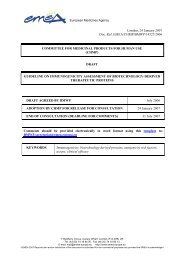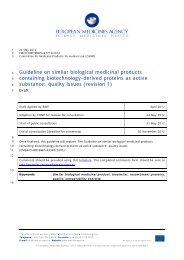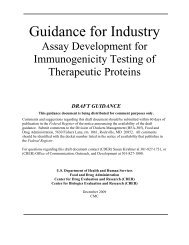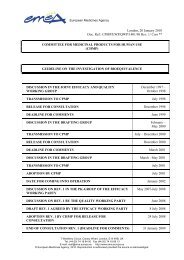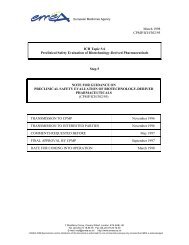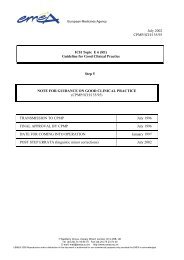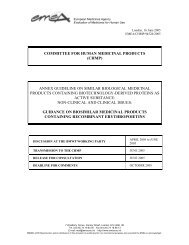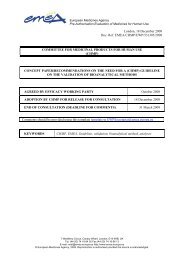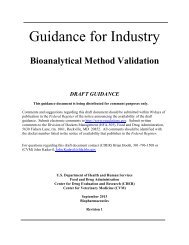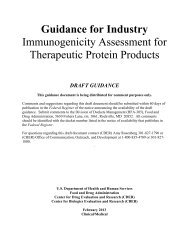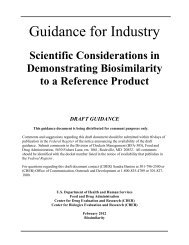Guidance for Industry - Assay Development
Assay Development for Immunogenicity Testing of Therapeutic Proteins, Draft Guidance http://www.ipm-biotech.de/fileadmin/user_upload/pdf/guidelines/FDA-GUIDANCE-Assay-Development-Immunogenicity-Testing.pdf
Assay Development for Immunogenicity Testing of Therapeutic Proteins, Draft Guidance
http://www.ipm-biotech.de/fileadmin/user_upload/pdf/guidelines/FDA-GUIDANCE-Assay-Development-Immunogenicity-Testing.pdf
Create successful ePaper yourself
Turn your PDF publications into a flip-book with our unique Google optimized e-Paper software.
741<br />
742<br />
743<br />
744<br />
745<br />
746<br />
747<br />
748<br />
749<br />
750<br />
751<br />
752<br />
753<br />
754<br />
755<br />
756<br />
757<br />
758<br />
759<br />
760<br />
761<br />
762<br />
763<br />
764<br />
765<br />
766<br />
767<br />
768<br />
769<br />
770<br />
771<br />
772<br />
773<br />
774<br />
775<br />
776<br />
777<br />
778<br />
779<br />
780<br />
781<br />
782<br />
783<br />
784<br />
785<br />
786<br />
Contains Nonbinding Recommendations<br />
Draft — Not <strong>for</strong> Implementation<br />
product exists. Several approaches <strong>for</strong> minimizing interference from RF have proven useful,<br />
including treatment with aspartame (see section VIII, 10) and careful optimization of reagent<br />
concentrations so as to reduce background binding. FDA recommends examining immune<br />
responses to Fc fusion proteins in clinical settings where RF is present to develop an antigenic<br />
moiety that corresponds to the non-Fc region of the molecule and assess whether patient serum<br />
binds the truncated product. For example, <strong>for</strong> a cytokine-Fc fusion protein, measuring antibody<br />
responses to the purified cytokine can help in assessing the specific immunogenicity of the<br />
fusion protein.<br />
3. Fusion Proteins<br />
Examination of immune responses to fusion proteins can be challenging and may require<br />
development of multiple assays to measure immune responses to both domains of the molecules<br />
as well as to the neoantigen <strong>for</strong>med at the junction of the components.<br />
4. High Levels of Endogenous Protein in Sera<br />
If serum/plasma possess high levels of protein that are analogous to the product under study,<br />
developing traditional antibody binding assays to measure relevant antibodies can be particularly<br />
challenging. For example, studies looking at immune response to albumin can be confounded by<br />
large quantities of serum albumin. In these instances, other approaches <strong>for</strong> measuring<br />
immun ogenicity may be warranted, such as enzyme-linked immunosorbent spot (ELISPOT) or<br />
plaque type assays, to measure numbers of antigen-specific antibody secreting cells.<br />
VII. OTHER ASPECTS OF IMMUNOGENICITY TESTING<br />
A. Isotypes<br />
While the initial screening assay should be able to detect all isotypes, in some circumstances the<br />
applicant should develop assays that discriminate between antibodies of specific isotypes. For<br />
example, <strong>for</strong> products that induce allergic responses, assays that can specifically measure levels<br />
of IgE may be important <strong>for</strong> helping predict and prepare <strong>for</strong> anaphylactic reactions in the clinic.<br />
In addition, the generation of immunoglobulin G4 (IgG4) antibodies has been associated with<br />
immune responses generated under conditions of chronic antigen exposure such as with factor<br />
VIII tre atment. IgG4 antibodies have also been shown to be less pathogenic as they fail to fix<br />
complement and are associated with blocking of allergic responses (section VIII, 11).<br />
Consequently, determining if antibody responses occurring upon prolonged exposure to<br />
therapeutic proteins are associated with this isotype may be useful.<br />
B. Epitope Specificity<br />
FDA recommends the applicant direct initial screening tests against the whole molecule and its<br />
endogenous counterpart. However, <strong>for</strong> product development, the applicant should investigate the<br />
regions or “epitopes” to which immune responses are specifically generated. This determination<br />
may be particularly important with fusion molecules in which two proteins are genetically or<br />
physically fused. In these circumstances, the region where the two molecules join may <strong>for</strong>m a<br />
C:\8495dft.doc<br />
11/4/09<br />
18




